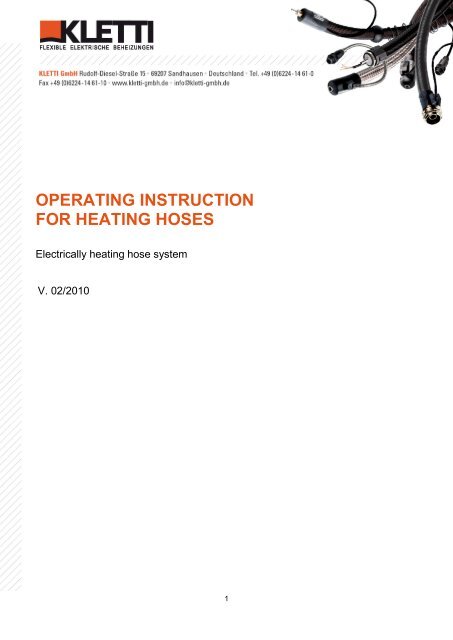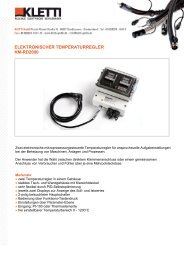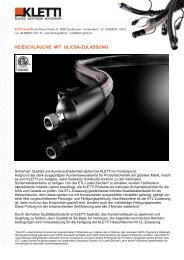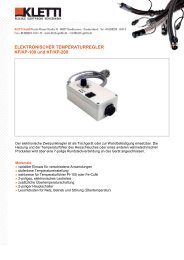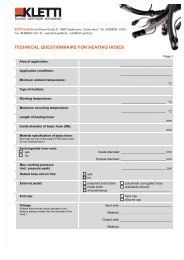OPERATING INSTRUCTION FOR HEATING HOSES - Kletti GmbH
OPERATING INSTRUCTION FOR HEATING HOSES - Kletti GmbH
OPERATING INSTRUCTION FOR HEATING HOSES - Kletti GmbH
Create successful ePaper yourself
Turn your PDF publications into a flip-book with our unique Google optimized e-Paper software.
<strong>OPERATING</strong> <strong>INSTRUCTION</strong><br />
<strong>FOR</strong> <strong>HEATING</strong> <strong>HOSES</strong><br />
Electrically heating hose system<br />
V. 02/2010<br />
1
INDEX<br />
Construction ............................................................................................................ 3<br />
Safety level: Thermal safety .................................................................................... 3<br />
Safety Instructions ................................................................................................... 4<br />
Installation Instructions ............................................................................................ 4<br />
Commissioning......................................................................................................... 5<br />
Pressure Hoses ....................................................................................................... 6<br />
Correction factors.................................................................................... ................ 6<br />
Placing Instructions.................................................................................................. 7<br />
Placing Instructions ................................................................................................. 8<br />
Placing Instructions ................................................................................................. 9<br />
Note on Fittings ......................................................................................................10<br />
Maintenance and Repair ........................................................................................10<br />
Technical data / Tolerances....................................................................................10<br />
Warranty.................................................................................................................10<br />
Appendix ................................................................................................................11<br />
Handling of heated hoses when used for industrial robots.....................................11<br />
Instructions for exchanging replaceable inner cores.............................................. 12<br />
Manual addendum for the installation, implementation and operating<br />
of heating tubes within the hazardous area....................................................... .....12<br />
Hose accessories.................................................................................................. . 13<br />
Electronic temperature control.................................................................................14<br />
Quality management............................................................................................... 15<br />
Contact ................................................................................................................... 15<br />
2
CONSTRUCTION<br />
The thermal insulation can be selected according to the operating temperature or by outer environmental effects<br />
and is protected against mechanical damage by an outside protective braid. On both ends, silicone caps or<br />
polyamide hard caps are mounted.<br />
Usually, a standard plug as a standard feature for connection to our temperature control (see page 10), is<br />
mounted with the leads for heating, temperature sensor and control lines or the individual conductors are marked<br />
appropriately.<br />
Before using the heating hose, carefully read and observe the safety and installation instructions.<br />
Safety level: Thermal safety<br />
Level 0: No safety equipment only controlled operation – an overheating because of<br />
design feature is excluded (Regulator)<br />
Level 1: With temperature regulator or – watcher (clicker)<br />
Level 2: With adjustable temperature regulator or –watcher (temperature regulator<br />
and delimiter combination)<br />
3<br />
As a rule, the heating hose consists of a highquality<br />
PTFE inner hose through which the liquid<br />
or gaseous medium flows. The inner hoses are<br />
resistant to high temperatures up to 250°C, high<br />
operating pressures and aggressive substances<br />
to cover a wide range of applications. Selection of<br />
the type of pressure hose can be accomplished<br />
on the basis of the operating pressure required<br />
(see list on page 5).<br />
The appropriate fitting can be press-fitted to the<br />
basic hose. Please observe that the inner<br />
diameter of the fitting is not identical with the<br />
nominal width of the hose and therefore restricts<br />
the hose passage.<br />
The heating conductor is laid out according to<br />
VDE guidelines, is protected against moisture and<br />
the protective conductor is protected by a braided<br />
jacket. A temperature sensor is installed to control<br />
the operating temperature of the heated hose –<br />
as a standard feature; the sensor is located<br />
approximately 300 mm in back of the electrical<br />
outlet. If additional control lines or single-wire<br />
conductors are required, they can also be<br />
incorporate into the heating hose.
SAFETY <strong>INSTRUCTION</strong>S<br />
When planning, installing; testing and operating as well as for repair, always observe:<br />
» these operating instructions<br />
» DIN EN 60519-1 "Safety in Electrical heating systems"<br />
Part 1 : General requirements ( = IEC 519-1 = VDE 0721, Part 911)<br />
» applicable part of VDE 100<br />
» as well as other standards and regulations applicable for such applications<br />
» all recognized rules of technology such as EN standards, VDE0100, Low-Voltage Guidelines<br />
EN 60204, Part 1, Machine Guidelines EN 292 and the Accident Prevention Regulations<br />
according to BGV A2<br />
Ensure that protection against dangerous body currents are provided as specified in VDE 0100, Part 410 and<br />
Part 540 (Grounding and System Grounding) as well as the specifications and the standards listed above.<br />
Ensure that the heating hose is installed only outside of explosion-hazard areas. It is not permissible to<br />
heat explosive mediums or mediums which release explosive gases when heated!<br />
Proper and safe operation of the heating hose assumes that the hose has been carefully transported, stored and<br />
properly installed.<br />
Ensure that heating hoses are installed and put into operation only by qualified personnel.<br />
Observe these operating instructions and operation of the device, particularly instructions and notes on routing,<br />
the applicable safety precautions for installation and operation of electrical equipment.<br />
Installation Instructions<br />
Please read these installation instructions carefully and observe all points listed when installing the equipment.<br />
Failure to observe these installation instructions can result in malfunctions or, under certain conditions, the<br />
required EMC Guidelines may not be fulfilled.<br />
Before connection and use of the heating hose, ensure that the operating voltage and the required operating<br />
voltage conditions for the heating hose conform with the local conditions (see type plate and technical data).<br />
Ensure that the load voltage is switched off on site and secure against being switched back on while installing<br />
the heating hose. Complete electrical connections in conformance with the connection diagram and applicable,<br />
electric-technical regulations. Route the supply lines to the heating hose so that they are free of tension under all<br />
conditions and cannot be pinched or sheared off under any circumstances. If possible, use shielded cable for the<br />
sensor lines and signal lines and shielded compensation lines for the thermocouples. Fuse the heating hose load<br />
circuit against excessive current.<br />
These instructions do not contain all information on regulations, standards, etc. to be observed when<br />
working on heating hose in combination with systems. It is the responsibility of the operator of the<br />
equipment to compile and observe these regulations and standards, etc. as required for the specific<br />
application.<br />
4
COMMISSIONING<br />
Before putting the heating hose into operation, observe the following:<br />
» Specifications on type plate must coincide with your order data<br />
» Use only temperature controls compatible with the type of sensor in the heating hose.<br />
» Ensure that the line voltage coincides with the voltage specified on the type plate.<br />
» Ensure that the nominal power for the heating hose does not exceed the maximum power output of<br />
the connected temperature control or power output from the equipment (resistive load).<br />
» Never operate the heating hose without temperature sensor (connected to temperature control),<br />
because otherwise it heats up without control and exceeds the maximum operating temperature<br />
which can lead to damage to the heating hose and your equipment.<br />
» Provide for a protective system to protect the line against excessive temperature in the event of overload.<br />
Line protection according to VDE 0721, Part 1, Section 19, must ensure that the nominal value of the fuse<br />
is matched to the specific load and must be connected in series in front of the heating hose (including control).<br />
However, the max. fuse rating must not exceed 16A. We recommend using a conductor with a cross section of<br />
at least 1.5mm²<br />
» If the heating hose is suspended or fastened with clamps, ensure that the outer diameter of the heating hose<br />
is not reduced by more than 10%.<br />
» Ensure that connection fittings are not under tension, under any circumstances.<br />
» It is necessary for the heating hose to reach its operating temperature before it is subjected to<br />
your operating pressure, because the medium could still be rigid at the fittings.<br />
» The time required to heat up the heating hose to operating temperature is approx. 15-30 minutes, as<br />
a rule. As soon as the hose reaches his operating temperature the fittings have to be tightening<br />
again. When starting up the system for the first time or restarting; ensure that the medium in the<br />
heating hose has reached its processing temperature to avoid damage to the inner hose.<br />
» Observe minimum bending radiuses! (see page 5).<br />
» Kinks and high torsion loads lead to destruction of the heating hose.<br />
» Observe placing instructions (see pages 6 to 8)<br />
» The resistance of the flexible heating hoses to pressure changes at various operating temperatures<br />
(see list on page 5). In the range up to 250°C, the pressure resistance can be specified, however,<br />
this decreases down to 0 bars at temperatures above 250°C. The maximum operating pressure should<br />
be calculated with a corresponding correction factor, depending on the maximum operating temperature.<br />
Also observe pressure surges. These can be very high and are not indicated by normal pressure gauges.<br />
Never exceed the operating pressure!<br />
» Hoses and PTFE tubing up to NW 8 have been tested for their suitability for use with vacuum down to<br />
8 mbar at temperatures up to 250°C.<br />
5
PRESSURE <strong>HOSES</strong><br />
T1<br />
Smooth PTFE hose<br />
with one woven layer of stainless steel wire (DIN 1.4301)<br />
nominal temperature 250°C<br />
Nominal diameter DN 4 6 8 10 12 16 20 25<br />
Working pressure in bar 275 240 200 175 150 135 100 80<br />
Burst pressure in bar 1100 920 800 700 600 540 400 320<br />
min. bending radius in mm 50 75 100 120 135 160 200 250<br />
T2<br />
Smooth PTFE hose<br />
with two woven layers of stainless steel wire (DIN 1.4301)<br />
nominal temperature 250°C<br />
Nominal diameter DN 6 8 10 12 16 20 25 32 40<br />
Working pressure in bar 275 250 225 200 175 150 130 70 50<br />
Burst pressure in bar 1100 1000 900 800 700 600 520 280 200<br />
min. bending radius in mm 75 100 120 135 160 200 250 500 850<br />
T3<br />
Smooth PTFE hose<br />
with two layers of high tensile steel wires and one braided steel wire<br />
nominal temperature 250°C<br />
Nominal diameter DN 6 8 10 12 16 20 25 32<br />
Working pressure in bar 500 475 450 400 400 300 275 250<br />
Burst pressure in bar 2000 1900 1800 1600 1600 1200 1000 1000<br />
min. bending radius in mm 75 100 120 135 160 200 240 280<br />
CORRECTION FACTORS<br />
for different operating temperatures<br />
The specified pressures apply for operating temperatures from 20°C to 50°C. Specifications or correction<br />
factors must be observed if using under different temperatures as follows:<br />
Operating temperature up to 24°C 100°C 200 °C 250°C<br />
Temperature correction factor 1,0 0,9 0,8 0,6<br />
6
PLACING <strong>INSTRUCTION</strong>S<br />
WRONG CORRECT<br />
Dragging at the ends of the rolled-up heated Unwind the roll instead of pulling the heated hose.<br />
hoses causes torsional stress, as well as too<br />
narrow a minimum bending radius.<br />
If heated hoses are too short, the heated hose Plan in a straight piece of heated hose<br />
will be kinked at the connections. (about 5 x hose diameter) at the connections.<br />
A wide bending radius ensures a longer durability.<br />
The heated hoses are often destroyed Make sure the axes of the heated hose<br />
by torsional motions caused by improper run parallel and the motions are always<br />
installation. on one and the same level.<br />
7
PLACING <strong>INSTRUCTION</strong>S<br />
WRONG CORRECT<br />
Avoid diversions, for they may cause kinking Use a saddle-shaped device or a roll,<br />
and bending stress. each with the appropriate diameter.<br />
Any inappropriate installation makes Use a spiral heated hose suspension.<br />
the heated hose sag.<br />
Heated hoses mounted within a closed channel Heated hoses must not touch each other.<br />
or shaft will cause heat built-up. Sufficient ventilation is to be provided.<br />
8
PLACING <strong>INSTRUCTION</strong>S<br />
WRONG CORRECT<br />
If e.g. powdery substances, adhesives, or other Constant cleaning and elimination of cause.<br />
thermo-insulating materials are spilled on<br />
heated hoses, those parts will overheat.<br />
Heated hoses bundling or embedding with contact Install heated hoses with sufficient spacing.<br />
will cause overheating of contact areas.<br />
With the mounting brackets, please do not squeeze<br />
the outer heat insulation onto the heating conductor<br />
during installation. This can cause damage of the<br />
protective layer, and may destroy the heated hose<br />
or damage the medium.<br />
Use a counter-wrench when installing to avoid<br />
twisting the heated hose!<br />
9
Note on Fittings<br />
The fittings size depends on the nominal width of the hose DN (NW).Please observe that the inner diameter<br />
of the fitting is not identical with the nominal width of the hose and therefore restricts the hose passage.<br />
nominal diameter DN (NW)<br />
of the PTFE core<br />
inner Diameter Fitting<br />
in mm<br />
4 6 8 10 12 16 20 25 32 40<br />
3,0 4,5 6,0 7,5 10,0 12,5 16,0 20,1 27,5 31,5<br />
Maintenance and Repair<br />
Perform maintenance and repair according to the standards and conditions specified under the point "Safety<br />
precautions" observing all applicable regulations of the employer's liability insurance association and other<br />
conditions applicable for the type of application. The heating equipment and control should be checked for<br />
proper function at least once a year and testing intervals observed according to BGV A2.<br />
Technical data / Tolerances<br />
See type plate on the heating hose<br />
Electrical tolerance of performance + 5 % / - 10 %<br />
Length tolerance + / - 2 %<br />
Warranty<br />
We assume a warranty for<br />
» our articles to be appropriately designed for a period of 12 months usage in single-shift operation* from<br />
their shipping date, to the extent that we will deliver ex-works Sandhausen free-of-charge replacements<br />
for all parts found to be prematurely defective due to design, workmanship or material faults when such<br />
defective items are freight-paid returned to Sandhausen. We are not liable for damage due to natural<br />
wear or improper handling. The guarantee period shall be reduced to 6 months for 2-shift operation or<br />
reduced to 4 months for 3-<br />
shift operation.<br />
» hoses of any type when proven to be a material defect. A fixed-period for guarantee is excluded since<br />
the durability is essentially dependent on handling care, i.e. from factors which are not under our control.<br />
In no case shall liability be accepted for damage beyond the free-of-charge replacement of defective parts. This<br />
applies equally to other claims for damage, i.e. compensation for outlays of wages, freight and the like are<br />
expressly refused.<br />
10
APPENDIX<br />
Handling of heated hoses when used<br />
for industrial robots<br />
The heated hoses for industrial robots are characterised by their special design. Due to the heavy dynamic<br />
load caused by the robot, the hose is equipped with a special outer sheath and a protective element for the<br />
inner temperature sensor in addition to various other specific measures.<br />
Figure 1 Figure 2<br />
Please make sure that the heated hose has a contact surface which is as large as possible and that it is<br />
attached to the robot with special hose protection elements (see figures 1 and 2). Do not use any cable ties to<br />
this end.<br />
Important:<br />
» It is of paramount importance not to undercut the specified bending radius of the heated hose.<br />
» For specific applications which demand a bending radius which is close to the limit and/or for<br />
excessively dynamic movements of the industrial robot, the heated hoses must be protected with<br />
hose protection springs or the like (see figures 3 and 4).<br />
» In the area of the temperature sensor the movement must be kept as low as possible.<br />
» In addition, you must make sure that the heated hose is neither compressed, twisted nor<br />
overstretched.<br />
» Furthermore you must pay attention to the fact that the heated hose is not pulled over any sharp<br />
edges or that it is not constantly subject to abrasion e.g. at a robot arm.<br />
Figure 3 Figure 4<br />
The more frequently a heated hose executes a movement per minute, the more important is the ideal choice of<br />
the outer sheath and its attachment to the robot. The service life of the heated hose (multi-shift operation) is the<br />
shorter, the more movements the hose is subject to per day (for this also see p.10 warranty).<br />
11
Instructions for exchanging replaceable inner cores<br />
» Please loosen the hexagon socket set screw (Ø 2.5mm) on both sides of the hose.<br />
» Unscrew the double nipple.<br />
» Now you can remove the inner hose from the support sleeve. Pull out the inner hose on the side<br />
of the pressed-in fitting.<br />
» The installation of the new inner hose is effected in reverse order of the disassembly<br />
Manual addendum for the installation, implementation and operating of<br />
heating tubes within the hazardous area<br />
Depending on their individual construction, prototype-tested, explosion-proof heating conductors or selflimiting<br />
heating bands are processed as “radiators”. Please ensure that for this type of equipment the corresponding<br />
certificate by an accredited checkpoint is on hand. The test number indicated on these certificates must be<br />
concordant with the imprint on the label of the corresponding equipment.<br />
Regarding the installation site, please consider that the heating is only appropriate for the permissible hazardous<br />
area and the permissible ambient air temperature.<br />
The heating tubes might reach temperatures above the permissible temperature level according to the<br />
temperature classification and thus may only be operated in combination with a thermostat delimiter.<br />
In case of the regulated heating tubes equipped with heating conductors, two PT-100 thermostats are used as<br />
standard, which can only be operated through intrinsically safe sensor-entries at the corresponding<br />
thermostat-delimiter combinations.<br />
The heating tube may only be installed with a thermostat-delimiter permissible for the corresponding hazardous<br />
area. In case the combination is installed outside the hazardous area, it only has to be equipped with intrinsically<br />
safe sensor-entries.<br />
Before the heat tube system can be put into operation, a start-up test according to § 14 of BetrSichV<br />
(industrial safety regulations) has to be conducted. This has to be differentiated from testing the whole<br />
plant according to BetrSichV, addendum 4 (3.2).<br />
Apart from the general regulations indicated in the user manual, regulations for the installation of electric systems<br />
within an explosive area also apply.<br />
The EN 60519-1 “Safety in electro heat installations Part 1: General requirements“as well as the EN 60519-2<br />
“Safety in electro heat installations Part 2: Particular requirements for resistance heating equipment.”<br />
The operator has to carefully ensure the following:<br />
» The permissible temperature and the permissible pressure must not be exceeded.<br />
» he thermostat-delimiter-combination has to be selected and tested in correspondence with<br />
their installation within the hazardous area.<br />
» The earthing measures of the heating tube have to be conducted and tested before its activation.<br />
» The heating tube has to be included in the local potential equalisation.<br />
» A ground fault circuit interrupter for 30 mA is provided for.<br />
12
HOSE ACCESSORIES<br />
For connecting, placing and guiding of heated hoses KLETTI offers the corresponding hose accessories.<br />
Coil ring with holding device Gripping clamps<br />
Article no.: 40001 Article no.: 40005<br />
Also suitable for heated hoses with polyamide<br />
braid.*<br />
Trumpet Jointed tubing<br />
Article no.: 40002 Article no.: 40003 (available from NW48)<br />
Middle-and end jaws Conduit protector<br />
Article no.: 40004 Article no.: 40000 (NW36)<br />
13
ELECTRONIC TEMPERATURE CONTROL<br />
Serves for optimum temperature monitoring of the heating hoses.<br />
Whether temperature maintenance or temperature increases, our control products satisfy high demands for<br />
control of heating equipment for machines, systems and processes.<br />
All of our electronic, micro-processor controlled temperature regulators have the following features:<br />
» stable table and wall housing with transparent cover<br />
» control and limiter system ready to plug in<br />
» two displays for indication of nominal and actual value<br />
» operation with function buttons<br />
» adjustment at parameter level<br />
» sensor input : Pt-100 or thermocouple<br />
» PID auto optimization<br />
» freely adjustable temperature range 0-1200°C<br />
» switching capacities up to 16 A possible<br />
Series KM-RD2000 Series KM-RD1000<br />
digital temperature regulator digital double temperature regulator<br />
Series KM-RD3000 Series KM-RD4011<br />
temperature regulator and delimiter temperature regulator and delimiter<br />
combination combination Ex-design<br />
14
QUALITY MANAGEMENT<br />
Safety, Quality and costumer satisfaction are our main goals:<br />
» Certification TÜV DIN ISO 9001 : 2000<br />
» From now on you can get some heated hoses from KLETTI with UL / CAS registration based on the<br />
security testing our products for the markets of the USA and Canada.<br />
» Anti-explosion certification for temperature category T3 in explosive areas in zones 1, 2 (gas)<br />
and 21, 22 (dust).<br />
CONTACT<br />
KLETTI <strong>GmbH</strong><br />
Rudolf Diesel Str.15<br />
69207 Sandhausen<br />
Germany<br />
Tel. +49 (0)6224 – 1461-0<br />
Fax +49 (0)6224 – 1461-10<br />
info@kletti-gmbh.de<br />
www.kletti-gmbh.de<br />
15


